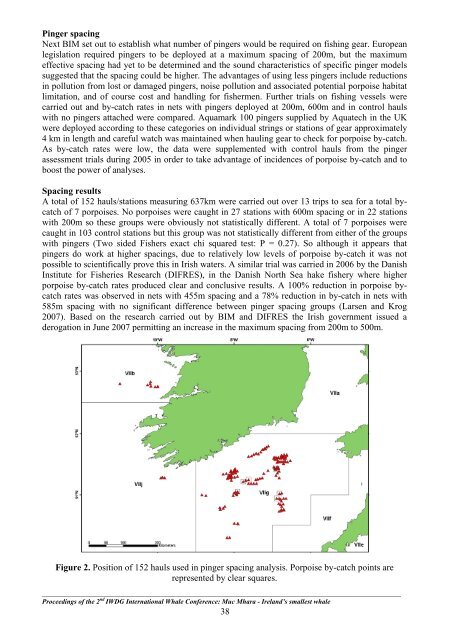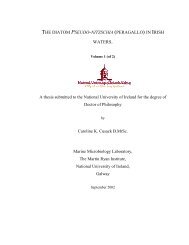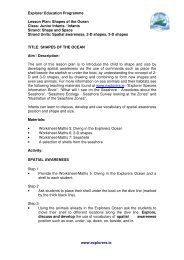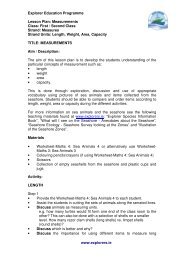Muc Mhara Ireland's Smallest Whale - Marine Institute Open Access ...
Muc Mhara Ireland's Smallest Whale - Marine Institute Open Access ...
Muc Mhara Ireland's Smallest Whale - Marine Institute Open Access ...
You also want an ePaper? Increase the reach of your titles
YUMPU automatically turns print PDFs into web optimized ePapers that Google loves.
Pinger spacing<br />
Next BIM set out to establish what number of pingers would be required on fishing gear. European<br />
legislation required pingers to be deployed at a maximum spacing of 200m, but the maximum<br />
effective spacing had yet to be determined and the sound characteristics of specific pinger models<br />
suggested that the spacing could be higher. The advantages of using less pingers include reductions<br />
in pollution from lost or damaged pingers, noise pollution and associated potential porpoise habitat<br />
limitation, and of course cost and handling for fishermen. Further trials on fishing vessels were<br />
carried out and by-catch rates in nets with pingers deployed at 200m, 600m and in control hauls<br />
with no pingers attached were compared. Aquamark 100 pingers supplied by Aquatech in the UK<br />
were deployed according to these categories on individual strings or stations of gear approximately<br />
4 km in length and careful watch was maintained when hauling gear to check for porpoise by-catch.<br />
As by-catch rates were low, the data were supplemented with control hauls from the pinger<br />
assessment trials during 2005 in order to take advantage of incidences of porpoise by-catch and to<br />
boost the power of analyses.<br />
Spacing results<br />
A total of 152 hauls/stations measuring 637km were carried out over 13 trips to sea for a total bycatch<br />
of 7 porpoises. No porpoises were caught in 27 stations with 600m spacing or in 22 stations<br />
with 200m so these groups were obviously not statistically different. A total of 7 porpoises were<br />
caught in 103 control stations but this group was not statistically different from either of the groups<br />
with pingers (Two sided Fishers exact chi squared test: P = 0.27). So although it appears that<br />
pingers do work at higher spacings, due to relatively low levels of porpoise by-catch it was not<br />
possible to scientifically prove this in Irish waters. A similar trial was carried in 2006 by the Danish<br />
<strong>Institute</strong> for Fisheries Research (DIFRES), in the Danish North Sea hake fishery where higher<br />
porpoise by-catch rates produced clear and conclusive results. A 100% reduction in porpoise bycatch<br />
rates was observed in nets with 455m spacing and a 78% reduction in by-catch in nets with<br />
585m spacing with no significant difference between pinger spacing groups (Larsen and Krog<br />
2007). Based on the research carried out by BIM and DIFRES the Irish government issued a<br />
derogation in June 2007 permitting an increase in the maximum spacing from 200m to 500m.<br />
Figure 2. Position of 152 hauls used in pinger spacing analysis. Porpoise by-catch points are<br />
represented by clear squares.<br />
_________________________________________________________________________________________________________<br />
Proceedings of the 2 nd IWDG International <strong>Whale</strong> Conference: <strong>Muc</strong> <strong>Mhara</strong> - Ireland’s smallest whale<br />
38





